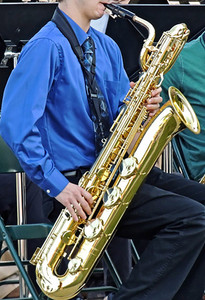Exploring the Different Types of Saxophones
- Taylor Fends

- Oct 10, 2024
- 3 min read

The saxophone is one of the most versatile and expressive instruments, found across multiple genres, from jazz to classical to pop. Developed in the mid-19th century by Adolphe Sax, it has become a staple in both solo and ensemble performances. But did you know that there are several types of saxophones, each with its own unique sound and purpose? In this post, we'll dive into the different types of saxophones and what makes each one special.
1. Soprano Saxophone
The soprano saxophone is the highest-pitched of the common saxophones and is known for its bright, piercing tone. It’s much smaller than its counterparts, making it easier to transport but also more challenging to play due to its smaller mouthpiece and reed.
Range: B♭3 to F6 (though altissimo notes can extend higher).
Best For: Jazz, classical, and modern music.
Famous Players: John Coltrane, Kenny G, Sidney Bechet.
While the soprano sax can be straight or curved, the straight version is more common. It’s often favored for its ability to cut through a dense musical arrangement, offering a voice that can soar above the rest.
2. Alto Saxophone
The alto saxophone is one of the most popular types for beginners, offering a balance between size, tone, and ease of play. It’s pitched in E♭ and has a rich, warm tone, making it suitable for both solo and ensemble work.
Range: D♭3 to A5 (with altissimo notes reaching higher).
Best For: Classical, jazz, pop, rock.
Famous Players: Charlie Parker, Cannonball Adderley, David Sanborn.
The alto saxophone is a favorite in jazz bands and classical saxophone quartets, and it’s also commonly used in marching bands and concert bands.
3. Tenor Saxophone
Slightly larger than the alto, the tenor saxophone is pitched in B♭ and has a deeper, more robust sound. Its mellow, rich timbre makes it a staple in jazz and rock music, giving it a soulful and sometimes gritty quality.
Range: A♭2 to E5.
Best For: Jazz, blues, rock, and classical.
Famous Players: John Coltrane, Sonny Rollins, Stan Getz.
The tenor sax is often seen as the "voice" of jazz, playing an essential role in big band and small combo settings. Its deep resonance makes it a great solo instrument, especially in blues and jazz improvisations.
4. Baritone Saxophone
The baritone saxophone, or "bari sax," is one of the largest and lowest-pitched saxophones in common use. Pitched in E♭, it has a deep, booming tone that adds weight to the bottom of saxophone sections and is often used for bass lines or supporting harmonies.
Range: C2 to A4.
Best For: Jazz, concert bands, marching bands, and classical music.
Famous Players: Gerry Mulligan, Harry Carney, Pepper Adams.
Due to its size, the baritone saxophone can be physically challenging to play, but its unique sound adds incredible depth and richness to any performance.
5. Other Saxophones: Bass, Contrabass, and Sopranino
While the four saxophones mentioned above are the most commonly used, there are other, less common members of the saxophone family worth exploring:
Bass Saxophone: Even larger than the baritone, this saxophone is pitched in B♭ and produces a deep, resonant sound. It’s used primarily in jazz bands and for experimental music.
Contrabass Saxophone: One of the largest and rarest saxophones, the contrabass is a behemoth instrument pitched in E♭, playing incredibly low notes. It's mostly found in experimental music and specialty performances.
Sopranino Saxophone: The smallest and highest-pitched saxophone, the sopranino is an E♭ instrument. It’s much less common, but its unique, shrill sound is sometimes used in avant-garde and contemporary music.
Different Types of Saxophones
The saxophone family is as diverse as it is dynamic, offering a wide range of tones and textures for different musical needs. Whether you’re a beginner looking to pick up your first alto sax or an experienced player seeking the low rumble of the baritone, there’s a saxophone out there for everyone. Each type of saxophone brings its own personality to the table, enhancing the richness of the music it creates.
By understanding the different types of saxophones, musicians can choose the instrument that best fits their style and needs, unlocking the full potential of this remarkable instrument.
























Comments